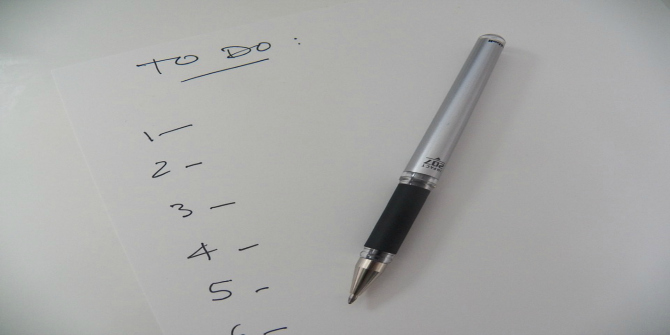 Early-career researchers are subject to higher levels of scrutiny than ever before, with publication in academic journals essential to how they are funded and evaluated, and how their careers will be built. Margaret K. Merga, Shannon Mason and Julia E. Morris share insights from their own experiences of navigating the journal submission and publication process as ECRs, emphasising the importance of being strategic about journal selection, understanding which suggested revisions will actually improve a paper, and knowing what is the right moment to contact the editor for guidance.
Early-career researchers are subject to higher levels of scrutiny than ever before, with publication in academic journals essential to how they are funded and evaluated, and how their careers will be built. Margaret K. Merga, Shannon Mason and Julia E. Morris share insights from their own experiences of navigating the journal submission and publication process as ECRs, emphasising the importance of being strategic about journal selection, understanding which suggested revisions will actually improve a paper, and knowing what is the right moment to contact the editor for guidance.
Publishing in quality peer-reviewed journals is essential for early-career researchers (ECRs), due to their need to build a track record and expertise in their field. ECRs are subject to higher levels of scrutiny than ever before, with our contributions quantified through performance measurement indicators which may fail to adequately capture their scope, the efforts applied, and our stage in career. As contended by Hyland, publication is essential “because it is through publication that knowledge is constructed, academics are evaluated, universities are funded, and careers are built, and each year its influence becomes ever more intrusive and demanding”. As ECRs, we are particularly vulnerable to this imperative, as many of us have yet to secure tenure, so we may lack the job security of our more-established senior colleagues.
The knowledge and skills needed to write an academic journal article for publication and then to successfully negotiate the peer review process are complex and unique. Many ECRs will have experienced inadequate training and mentoring in this area.
At the time of publishing our recent journal article that informs this post, we were all considered early-career researchers (<5 years post-PhD conferral) and had authorship of 65 peer-reviewed and published journal articles amassed between us. We shared many stories about the journeys to publication of these articles, including the numerous mistakes and pitfalls we encountered.
In this spirit of sharing and collegiality, here are some of the things we wish we’d known earlier. These are not exhaustive; we suggest you also read our paper, and we’d love for you to contribute your own insights in the comments below.
Choose your target carefully
Many factors can be taken into account when choosing the best journal to target. Research suggests that ECRs typically follow a simple strategy: publish as many journal articles in the best quality journals as we can. However, the more papers we put out for review, the more we became aware of the additional considerations that should guide our journal selection, which we feel can increase the chances of having your paper accepted. Some of the questions we might ask are: what kinds of voice do they like? What conversations are they promoting? Are they only publishing research that was conducted in the USA? Are they only publishing certain methods? In addition, there can be great differences in the length of the publication process from submission to publication. ECRs may value speed even more than our more experienced colleagues, as we’re still building the foundational structure upon which our career prospects will sit.
Follow-up is vital, but hold your horses
Once a paper is submitted to a journal, it can feel like our intellectual property is being held for ransom if the period of review blows out far beyond what we anticipated. After a certain point, we may begin murmuring about the need to follow up, but we may be unsure about when to do this. As you will read in our paper, Julia had a very unfortunate experience, where shortly after she submitted her paper, the journal scope changed and the editor rejected her article without notifying her. As she didn’t follow up, her article languished in oblivion for a year. On the other hand, Shannon had a negative experience after following up promptly. We suggest that if a turnaround time is not indicated in the author guidelines, we would follow up after three months if no correspondence from the journal has been forthcoming (though other disciplines may have different norms).
Not every revision is a good revision
While revisions typically enhance a paper, we no longer slavishly adhere to all suggested revisions. In our paper we note that “addressing the shortcomings of our work is a valuable opportunity to both learn from the peer review process and improve the quality of our submission”. However, not all revisions make the paper better, and the test that we suggest that ECRs objectively apply to each revision is this: will this revision improve my paper? Some revisions won’t improve a paper, but they won’t make it worse either, and so they can be accommodated.
The rationale behind suggested revisions is not always sound. For example, Margaret has been asked to add material for no apparent reason other than to improve the citation count of friends or associates of the editor and/or the journal or publisher. These could be classified as “insertions that constitute an improvement in the quality of the paper, those that seem to be requested solely to make the editor/reviewer/publisher happy in terms of exposure, and the type that does both”. Margaret noted that “the most absurd example was where I cited a work because I had to, only to point out (in the same paper!) that it did not explore the areas relevant to my research”. While this kind of cronyism can be part of the “game” of the journal publication process, it is an unfortunate and disheartening aspect of the journey, especially for ECRs.
The editor can provide guidance
One of the most frustrating things we have encountered as ECRs is contradictory peer reviews. For example, Reviewer 1 might ask you to reduce the methods section, while Reviewer 2 asks you to expand it. It is literally not possible to keep both reviewers happy. We suggest that you have two good options in this scenario. You can either choose to adhere to the reviewer who reflects your views and add this justification to the table of changes you submit with your revisions; or you can ask the editor to weigh in. We’ve had some great experience with editors in general, so, if in doubt, in circumstances where it is reasonable to request their adjudication, we suggest approaching the editor for clarification.
Conclusion
Getting papers published in high-quality journals is not an easy task, even for established academics. However, being strategic about journal selection, knowing how to negotiate the publication process, and effectively engaging with editors and reviewers are all ways in which we can increase our chances of a positive result.
To see the authors’ research in this area, please go to their project page on ResearchGate: “Publishing during PhD candidature and early career”.
Featured image credit: David Iskander, via Unsplash (licensed under a CC0 1.0 license).
Note: This article gives the views of the authors, and not the position of the LSE Impact Blog, nor of the London School of Economics. Please review our comments policy if you have any concerns on posting a comment below.
About the authors
 Margaret K. Merga currently works as a Senior Lecturer at Edith Cowan University in Western Australia. Margaret primarily conducts literacy research that spans the early years to adulthood. She also explores issues on educational psychology, adult education, higher education and health workforce education. She is currently working on projects related to the role of teacher librarians in fostering literacy in primary and secondary schools.
Margaret K. Merga currently works as a Senior Lecturer at Edith Cowan University in Western Australia. Margaret primarily conducts literacy research that spans the early years to adulthood. She also explores issues on educational psychology, adult education, higher education and health workforce education. She is currently working on projects related to the role of teacher librarians in fostering literacy in primary and secondary schools.
 Shannon Mason is Assistant Professor in the Faculty of Education at Nagasaki University in Japan. Her research interests include teacher attrition and retention, and language education pedagogy and policy. She is also interested in new approaches to doctoral education, and the experiences of early-career researchers.
Shannon Mason is Assistant Professor in the Faculty of Education at Nagasaki University in Japan. Her research interests include teacher attrition and retention, and language education pedagogy and policy. She is also interested in new approaches to doctoral education, and the experiences of early-career researchers.
 Julia E. Morris is a Senior Lecturer at Edith Cowan University in Western Australia and Honorary Research Fellow at the University of Melbourne. Her research primarily addresses issues of engagement, both students’ engagement with learning and teachers’ engagement with the profession. She promotes the use of research data as evidence to highlight how changes to teacher practices and the learning environment influence students’ cognitive and affective engagement.
Julia E. Morris is a Senior Lecturer at Edith Cowan University in Western Australia and Honorary Research Fellow at the University of Melbourne. Her research primarily addresses issues of engagement, both students’ engagement with learning and teachers’ engagement with the profession. She promotes the use of research data as evidence to highlight how changes to teacher practices and the learning environment influence students’ cognitive and affective engagement.








“Are they only publishing research that was conducted in the USA? ”
I thought it was only me! Some American journals that I used to get published in quite easily when I was working in the US, nowadays find reasons to reject my papers now I work in Europe. I used to wonder if it was the subject matter, but I think the work I do now (plague) is more interesting than what I was doing in the US (tooth decay bacteria), and actually is better quality now I have more experience. This must come down to prejudice/bias in review, whether by editors the reviewers, whether conscious or unconscious. If I experience this working in Europe, I wonder about how authors from Asia are faring. Surely there is an argument for removing the information about geographical location until publication.
Dear Petra,
Thank you for your comment. Unfortunately you are not the only one.
Our full paper (DOI: 10.1002/leap.1192) explores this in more depth.
I found it disconcerting to have a paper not sent for review recently, from a journal that markets itself as being ‘international’, because it did not have enough data on the United States. This was one of the major reasons (but granted not the only reason) I was given for its rejection. It’s a frustration that a) some journals are not transparent about the real scope (or lack thereof) of their publications, and b) the insistence that a study is somehow unworthy because it does not include data from a specific country. We are all informed and influenced by research that is broader (geographically and otherwise) than our own, often niche, areas.
But we shall go on!
Shannon
Canada has become an increasingly popular destination for international students.
” Research by Robert Boyce actually shows that first and second-year professors who participated in a report on writing productivity were capable of turn out more publishable pages every year by . To find out about Chiropractic Schools in Iowa and also other regions, we urge that you visit our website that you will see a large collection of top schools which are waiting to listen to from you.